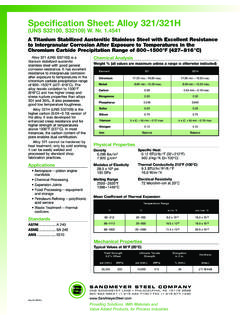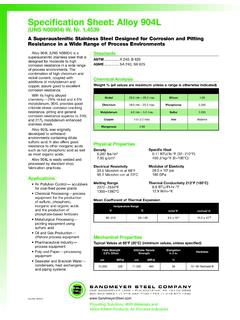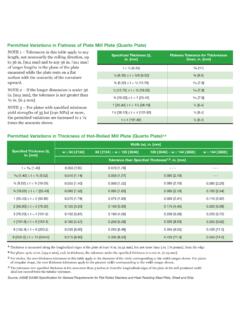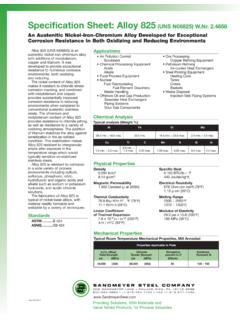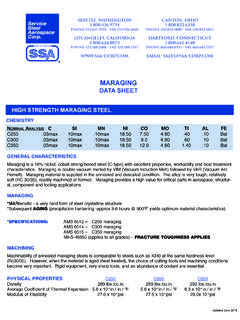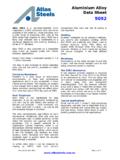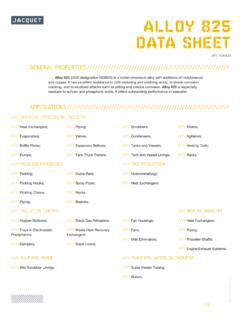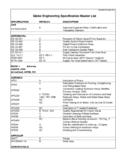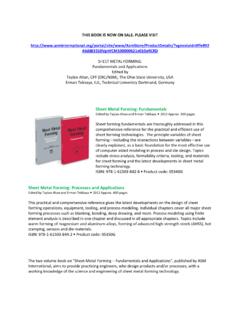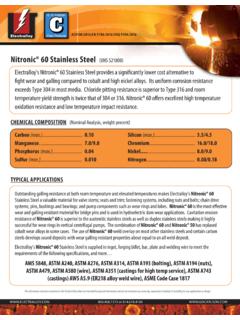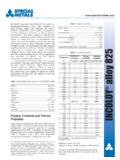Transcription of Specification Sheet: Alloy 316/316L - Sandmeyer Steel
1 Alloy 316/316L (UNS S31600/S31603) is a chromium-nickel-molybdenum austenitic stainless Steel developed to provide improved corrosion resistance to Alloy 304/304L in moderately corrosive environments. It is often utilized in process streams containing chlorides or halides. The addition of molybdenum improves general corrosion and chloride pitting resistance. It also provides higher creep, stress-to-rupture and tensile strength at elevated temperatures. It is common practice for 316l to be dual certified as 316 and 316l . The low carbon chemistry of 316l combined with an addition of nitrogen enables 316l to meet the mechanical properties of 316.
2 Alloy 316/316L resists atmospheric corrosion, as well as, moderately oxidizing and reducing environments. It also resists corrosion in polluted marine atmospheres. The Alloy has excellent resistance to intergranular corrosion in the as-welded condition. Alloy 316/316L has excellent strength and toughness at cryogenic temperatures. Alloy 316/316L is non-magnetic in the annealed condition, but can become slightly magnetic as a result of cold working or welding. It can be easily welded and processed by standard shop fabrication ..A 240 ASME ..SA 240 AMS ..5524/5507QQ-S ..766 Specification sheet : Alloy 316/316L (UNS S31600, S31603) W.
3 Nr. , Austenitic Stainless Steel Containing Molybdenum Which is More Corrosion Resistant than the Conventional 304/304L Stainless SteelAlloy 316- 316l 06 Steel COMPANYONE Sandmeyer LANE PHILADELPHIA, PA 19116-3598800-523-3663 +1-215-464-7100 FAX +1-215-677-1430 Providing Solutions, With Materials andValue Added Products, for Process IndustriesApplications Chemical and Petrochemical Processing pressure vessels, tanks, heat exchangers, piping systems, flanges, fittings, valves and pumps Food and Beverage Processing Marine Medical Petroleum Refining Pharmaceutical Processing Power Generation nuclear Pulp and Paper Textiles Water TreatmentPhysical PropertiesDensity lbs / in3 g /cm3 Modulus of Elasticity x 106 psi 200 GPaMelting Range 2450 2630 F 1390 1440 CSpecific Heat BTU/lb- F (32 212 F) 450 J/kg- K (0 100 C)Thermal Conductivity 212 F (100 C)
4 BTU/hr/ft2/ft/ F W/m- KElectrical Resistivity Microhm-in at 68 F 74 Microhm-cm at 20 CMean Coefficient of Thermal Expansionin/in/ F cm/cm C 68 212 20 100 x 10-6 x 10-6 68 932 20 500 x 10-6 x 10-6 68 1832 20 1000 x 10-6 x 10-6 Temperature Range F CChemical AnalysisWeight % (all values are maximum unless a range is otherwise indicated)in/in/ F Chromium min. max. min. max. Nickel min. max. min. max. Molybdenum min. max. min. max. Carbon Manganese Phosphorous Sulfur Silicon Nitrogen Iron Balance Balance Element316316 LMechanical PropertiesAt Room Temperature Offset Yield Strength, ksi 44 30 min.
5 25 min. Ultimate Tensile Strength, ksi 85 75 min. 70 min. Elongation in 2 inches, % 56 40 min. 40 min. Reduction in Area, % 69 Hardness, Rockwell B 81 95 max. 95 *ASTMType 316 Type 316l * inch plate1 Pitting Resistance Equivalent, including Nitrogen, PREN = Cr + + 16N 2 Critical Crevice Corrosion Temperature, CCCT, based on ASTM G-48B (6% FeCl3 for 72 hr, with crevices 3 Critical Pitting Temperature, CPT, based on ASTM G-48A (6% FeCl3 for 72 hr)Corrosion Resistance Type 304 Type 316 Type 317 SSC-6MO Alloy Cr Mo N PREN1 F ( C) F ( C) CCT2 CPT3< (< ) ( ) ( )110 ( ) 59 ( )66 ( )149 (65)Composition (Weight Percent))
6 In most applications Alloy 316/316L has superior corrosion resistance to Alloy 304/304L. Process environments that do not corrode Alloy 304/304L will not attack this grade. One exception, however, is in highly oxidizing acids such as nitric acid where stainless steels containing molybdenum are less resistant. Alloy 316/316L performs well in sulfur containing service such as that encountered in the pulp and paper industry. The Alloy can be used in high concentrations at temperatures up to 120 F (38 C). Alloy 316/316L also has good resistance to pitting in phosphoric and acetic acid. It performs well in boiling 20% phosphoric acid.
7 The Alloy can also be used in the food and pharmaceutical process industries where it is utilized to handle hot organic and fatty acids in an effort to minimize product 316/316L performs well in fresh water service even with high levels of chlorides. The Alloy has excellent resistance to corrosion in marine environments under atmospheric conditions. The higher molybdenum content of Alloy 316/316L assures it will have superior pitting resistance to Alloy 304/304L in applications involving chloride solutions, particularly in an oxidizing environment. In most instances, the corrosion resistance of alloys 316 and 316l will be roughly equal in most corrosive environments.
8 However, in environments that are sufficiently corrosive to cause intergranular corrosion of welds and heat-affected zones Alloy 316l should be used because of its low carbon content. 1 54 2 54 WPA P2O5 Cl- F- H2SO4 Fe2O3 Al2O3 SiO2 CaO MgOps = pitting can occur ps = pitting/crevice corrosion can occurLowest Temperature ( F) at Which the Corrosion Rate Exceeds 5 mpy Hydrochloric Acid >Boiling >Boiling >Boiling >Boiling 1% Hydrochloric Acid 86 86p 185 >Boiling 10% Sulfuric Acid 122 140 167 60% Sulfuric Acid <54 <59 <57 96% Sulfuric Acid 113 77 86 85% Phosphoric Acid 203 176 194 203 10% Nitric Acid >Boiling >Boiling >Boiling >Boiling 65% Nitric Acid 212 212 221 230 80% Acetic Acid >Boiling 212p >Boiling >Boiling 50% Formic Acid 104 50 194 194 50% Sodium Hydroxide 194 185 194 230 83% Phosphoric Acid + 2% Hydrofluoric Acid 149
9 113 122 140 60% Nitric Acid + 2% Hydrochloric Acid >140 >140 >140 >140 50% Acetic Acid + 50% Acetic Anhydride 248 >Boiling 212 230 1% Hydrochloric Acid + Ferric Chloride 77p 68p 113ps 203ps 10% Sulfuric Acid + 2000ppm Cl- + N2 77 95 122 10% Sulfuric Acid + 2000ppm Cl- + SO2 <<59p <59 104 WPA1, High Cl- Content 50 <<50 113 203 WPA2, High F- Content 50 <<50 140 167 CORROSION ENVIRONMENT Type Type 2205 2507 316l 304 (UNS S32205)SANDMEYERSTEEL COMPANYF abrication data Alloy 316/316L can be easily welded and processed by standard shop fabrication Forming Working temperatures of 1700 2200 F (927 1204 C)
10 Are recommended for most hot working processes. For maximum corrosion resistance, the material should be annealed at 1900 F (1038 C) minimum and water quenched or rapidly cooled by other means after hot Forming The Alloy is quite ductile and forms easily. Cold working operations will increase the strength and hardness of the Alloy and might leave it slightly Alloy 316/316L can be readily welded by most standard processes. A post weld heat treatment is not Alloy 316/316L is subject to work hardening during deformation and is subject to chip breaking. The best machining results are achieved with slower speeds, heavier feeds, excellent lubrication, sharp tooling and powerful rigid information and data in this product data sheet are accurate to the best of our knowledge and belief, but are intended for informational purposes only, and may be revised at any time without notice.



